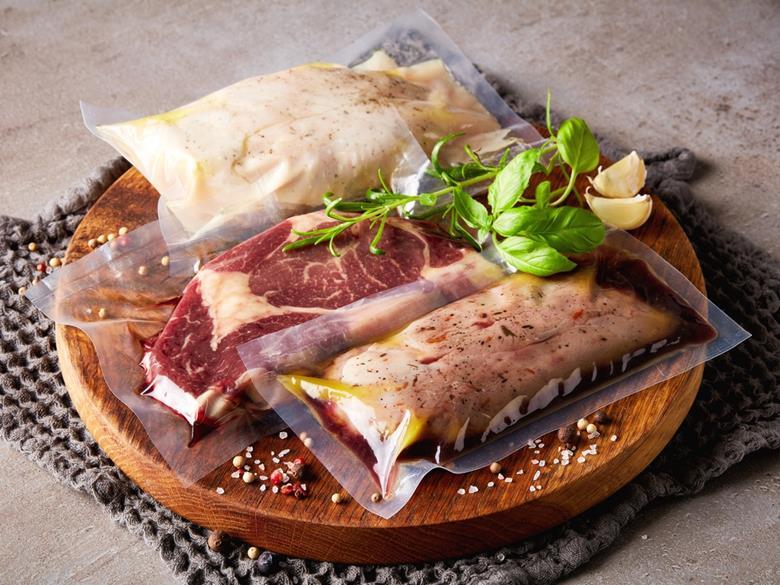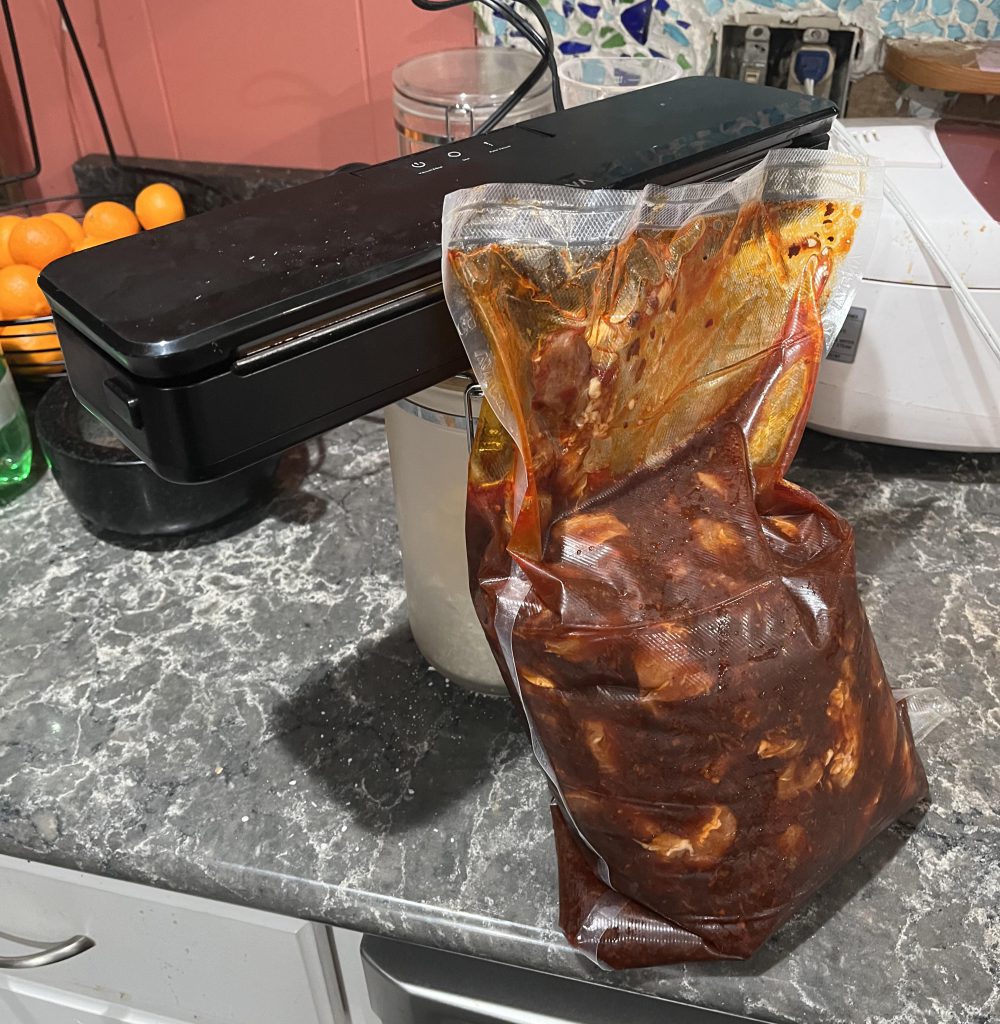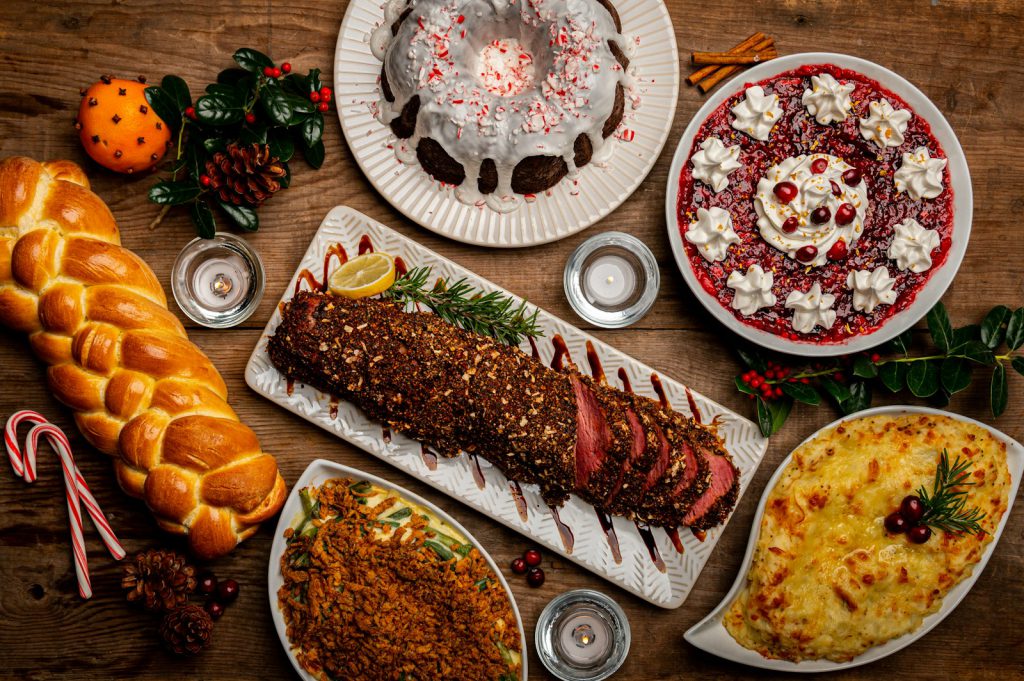Vacuum sealing has revolutionised the culinary world, especially in BBQ catering, by preserving food and enhancing flavors. The process involves removing air from a package before sealing it, which not only extends shelf life but also locks in the essence of marinades and spices. This method ensures that the BBQ products remain as fresh as the day they were prepared, retaining their juicy and tender qualities.
By vacuum sealing, the natural flavours of the meat are preserved and intensified, making every bite a burst of taste. This article delves into various techniques and tips to maximise the flavour of vacuum sealed BBQ products, making them irresistibly delicious. We will explore the benefits of vacuum sealing, the science behind it, and practical tips for selecting marinades, using spices and herbs, and employing sous vide cooking to achieve perfect results.

Benefits of Vacuum Sealing for BBQ Flavour
Vacuum sealing offers numerous advantages, particularly for BBQ enthusiasts and caterers. The primary benefits include extended shelf life, enhanced flavour infusion, and reduced risk of freezer burn. By eliminating air, vacuum sealing preserves the natural moisture and juices of the meat, ensuring it remains tender and flavorful.
- Extended Shelf Life: Vacuum sealing significantly prolongs the freshness of BBQ products. In a typical environment, meat begins to degrade due to the presence of oxygen and bacteria. Vacuum sealing removes this oxygen, thereby slowing down the decomposition process. This means that BBQ products can be stored for weeks or even months without losing quality, making it an ideal choice for caterers who need to prepare in advance.
- Enhanced Flavour Infusion: When meat is vacuum sealed with marinades or spices, the absence of air pressure allows the flavours to penetrate deeper into the meat. This results in a more intense and consistent flavour profile throughout the meat. The vacuum process also helps retain the natural juices of the meat, enhancing its taste and texture.
- Reduced Freezer Burn: Freezer burn occurs when meat is exposed to air and the moisture in the meat evaporates, leading to dry, tough patches. Vacuum sealing eliminates this problem by creating an airtight environment, ensuring that the meat retains its moisture and remains tender and juicy.
| Benefit | Description |
|---|---|
| Extended Shelf Life | Vacuum sealing significantly prolongs the freshness of BBQ products. |
| Enhanced Flavour | Marinades and spices penetrate deeper, resulting in more robust flavours. |
| Reduced Freezer Burn | The absence of air prevents the formation of ice crystals on the meat. |
Additionally, vacuum sealing can streamline the preparation process. By marinating and vacuum sealing meat in advance, caterers can reduce preparation time on the day of the event. This not only ensures consistency in flavour and quality but also allows for more efficient use of time and resources.
Choosing the Right Marinade
Selecting the appropriate marinade is crucial for enhancing the flavour of vacuum sealed BBQ products. Marinades can be acidic, enzymatic, or oil-based, each offering unique flavour profiles and benefits. Acidic marinades, for example, tenderise the meat while imparting a tangy taste. Enzymatic marinades, derived from fruits like pineapple or papaya, break down proteins and make the meat softer. This section provides a list of popular marinades and their characteristics.
Acidic Marinades
Acidic marinades, such as those made with vinegar, citrus juice, or wine, work by breaking down the proteins in the meat, making it more tender. They are perfect for tougher cuts of meat that require tenderising. The acidity also imparts a refreshing tanginess to the BBQ, making it more vibrant and zesty. A classic example is a lemon-garlic marinade, which combines the acidity of lemon with the aromatic flavour of garlic.
Enzymatic Marinades
Enzymatic marinades use natural enzymes found in certain fruits to tenderise meat. Pineapple and papaya are the most common fruits used for this purpose. The enzymes in these fruits break down protein structures in the meat, making it incredibly tender. However, care must be taken not to over-marinate, as the meat can become mushy. For instance, a pineapple-teriyaki marinade not only tenderises the meat but also adds a sweet and tangy flavour.

Oil-based Marinades
Oil-based marinades, made with olive oil or other oils, help in retaining moisture within the meat while adding a rich, smooth texture. The oil acts as a carrier for herbs and spices, ensuring that the flavours are evenly distributed throughout the meat. These marinades are particularly good for lean meats that can dry out easily during cooking. A popular example is a rosemary-garlic olive oil marinade, which infuses the meat with a fragrant, herbaceous flavour.
| Type of Marinade | Ingredients | Benefits |
|---|---|---|
| Acidic | Vinegar, citrus juice | Tenderises meat, adds tangy flavour |
| Enzymatic | Pineapple, papaya | Breaks down proteins, makes meat tender |
| Oil-based | Olive oil, herbs, garlic | Infuses flavour, keeps meat moist |
Each type of marinade has its own unique characteristics and benefits, allowing for a wide range of flavour profiles and textures. By experimenting with different combinations, BBQ enthusiasts can create a variety of delicious and unique dishes.
The Science of Vacuum Sealing and Flavour Infusion
Understanding the science of vacuum sealing helps in appreciating its impact on flavour enhancement. The process of removing air creates a vacuum environment, which increases the surface area of the meat exposed to the marinade. This facilitates deeper penetration of flavours. Additionally, the lack of oxygen prevents the growth of aerobic bacteria, maintaining the quality and taste of the BBQ products.
How Vacuum Sealing Works
When air is removed from the packaging, it creates a vacuum that forces the marinade into the meat’s porous structure. This pressure allows the flavours to infuse more deeply and evenly. The vacuum environment also helps in retaining the meat’s natural juices, preventing it from drying out. This results in a more flavorful and tender BBQ product.
Preservation of Quality
The absence of oxygen is crucial for preserving the quality of the meat. Oxygen is a key factor in the growth of aerobic bacteria, which can cause spoilage and off-flavours. By vacuum sealing, the environment becomes inhospitable for these bacteria, thereby extending the shelf life and maintaining the quality of the meat. This is especially important for BBQ caterers who need to ensure the freshness and safety of their products.
Steps of flavour Infusion Process
- Meat is placed in a vacuum bag with marinade.
- Air is removed, creating a vacuum environment.
- The marinade is forced into the meat’s porous structure.
- Flavours penetrate deeply, resulting in enhanced taste and tenderness.
Techniques for Marinating Vacuum Sealed BBQ Products
There are several techniques to effectively marinate vacuum sealed BBQ products. One popular method is to pre-marinade the meat before sealing it. This allows the flavours to infuse during the sealing process. Another technique is to marinate the meat after sealing by injecting marinades into the vacuum sealed package. This section discusses these techniques in detail, along with tips for optimal results.
Pre-Marinading Before Sealing
This method involves marinating the meat in a mixture of spices and liquids before vacuum sealing. The pressure from the vacuum helps the marinade penetrate deeper into the meat.
- Choose the Right Marinade: Select a marinade that complements the type of meat you are using. For instance, a spicy chili-lime marinade works well with chicken, while a garlic-herb marinade is perfect for beef.
- Marinate the Meat: Place the meat in a shallow dish and pour the marinade over it. Ensure that the meat is fully coated.
- Vacuum Seal the Meat: Transfer the marinated meat into a vacuum sealing bag. Ensure that there is enough space around the meat for the marinade to move during the sealing process.
- Seal and Store: Vacuum seal the bag, ensuring that all air is removed. Store the sealed meat in the refrigerator for the recommended marinating time.
Injecting Marinades After Sealing
Using a marinade injector, flavours can be introduced into the meat even after vacuum sealing. This method ensures that the meat absorbs the marinade evenly.
- Prepare the Marinade: Mix your chosen marinade in a bowl.
- Fill the Injector: Draw the marinade into the injector.
- Inject the Marinade: Insert the needle of the injector into the meat at various points, ensuring that the marinade is evenly distributed.
- Massage the Meat: Gently massage the meat to help distribute the marinade evenly.
Experimenting with Spices and Herbs
Spices and herbs play a pivotal role in enhancing the flavour of vacuum sealed BBQ products. Experimenting with different combinations can lead to unique and delightful flavours. Common spices used in BBQ include paprika, cumin, and black pepper, while herbs like rosemary, thyme, and oregano add aromatic notes. This section provides a list of spice and herb combinations for various types of meat.
- Beef: Black pepper, garlic, rosemary, and thyme are classic choices that enhance the rich flavour of beef. A combination of these spices with a touch of sea salt can create a robust and savoury taste.
- Chicken: Paprika, cumin, oregano, and basil add a warm and earthy flavour to chicken. These spices work well in both dry rubs and marinades.
- Pork: Mustard powder, sage, fennel seeds, and parsley provide a unique and aromatic flavour to pork. The sweetness of fennel seeds paired with the earthiness of sage and the freshness of parsley can transform pork into a flavorful delight.
- Lamb: Mint, coriander, garlic, and lemon zest complement the robust flavour of lamb. The freshness of mint and the citrusy notes of lemon zest balance the richness of the lamb, creating a harmonious taste.
Creating Custom Spice Blends
Creating custom spice blends allows for creativity and personalization in BBQ cooking. Here are a few examples of custom blends for different types of meat:
- Spicy BBQ Rub for Beef:
- 2 tablespoons black pepper
- 1 tablespoon garlic powder
- 1 tablespoon smoked paprika
- 1 teaspoon cayenne pepper
- 1 teaspoon dried thyme
- Herb Infusion for Chicken:
- 2 tablespoons dried oregano
- 1 tablespoon cumin powder
- 1 tablespoon paprika
- 1 teaspoon dried basil
- 1 teaspoon onion powder
- Sweet and Savory Mix for Pork:
- 2 tablespoons mustard powder
- 1 tablespoon brown sugar
- 1 tablespoon fennel seeds
- 1 teaspoon dried sage
- 1 teaspoon ground coriander
- Mediterranean Blend for Lamb:
- 2 tablespoons dried mint
- 1 tablespoon ground coriander
- 1 tablespoon garlic powder
- 1 teaspoon lemon zest
- 1 teaspoon sea salt
By experimenting with these combinations and adjusting the quantities to suit personal taste preferences, BBQ enthusiasts can discover their signature flavours.
Using Liquid Smoke for Authentic BBQ Flavour
Liquid smoke is a powerful tool for achieving an authentic BBQ flavour, especially when smoking is not an option. It is made by condensing the smoke from burning wood, capturing its essence in liquid form. Adding a few drops to the marinade or directly to the vacuum sealed package can impart a smoky flavour to the meat. This section discusses the types of liquid smoke available and how to use them effectively.
Types of Liquid Smoke
Liquid smoke comes in various wood flavours, each offering a distinct aroma and taste:
- Hickory: Known for its strong, hearty flavour, hickory liquid smoke is ideal for beef and pork. It imparts a robust smokiness reminiscent of traditional BBQ pits.
- Mesquite: Mesquite liquid smoke has a bold, intense flavour with a slightly sweet undertone. It is perfect for adding a Southwestern flair to chicken and beef.
- Applewood: Applewood liquid smoke offers a mild, fruity flavour that pairs well with pork and poultry. Its subtle sweetness enhances the natural flavours of the meat.
- Cherrywood: With a delicate and slightly sweet profile, cherrywood liquid smoke is great for adding a touch of smokiness to lamb and fish.
How to Use Liquid Smoke
Using liquid smoke effectively requires a balance to avoid overpowering the meat:
- Marinades: Add a few drops of liquid smoke to your marinade. Start with a small amount, as liquid smoke is highly concentrated. Adjust to taste, keeping in mind that the flavour will intensify during cooking.
- Direct Application: For a quick infusion of smoky flavour, apply liquid smoke directly to the meat before vacuum sealing. Use a brush to evenly distribute a small amount on the surface.
- Combining with Spices: Mix liquid smoke with your spice blend to create a dry rub with a hint of smokiness. This method works well for ribs and brisket.
Sous Vide Cooking and Vacuum Sealing
Sous vide cooking, combined with vacuum sealing, is a game-changer for BBQ enthusiasts. This method involves cooking vacuum sealed meat in a water bath at a precisely controlled temperature. The result is perfectly cooked meat with enhanced flavours. This section explores the benefits of sous vide cooking, provides a step-by-step guide, and includes tables for recommended cooking temperatures and times for different types of meat.
Benefits of Sous Vide Cooking
Sous vide cooking offers several advantages that complement the vacuum sealing process:
- Consistent Results: Sous vide ensures that the meat is cooked evenly from edge to edge, eliminating the risk of overcooking or undercooking. This is particularly beneficial for larger cuts of meat like brisket and ribs.
- Enhanced Flavour: Cooking meat in its own juices within a vacuum sealed bag intensifies the flavours. The meat absorbs the marinade and spices more effectively, resulting in a rich and robust taste.
- Tenderness: The precise temperature control of sous vide cooking allows for prolonged cooking times at lower temperatures, breaking down tough muscle fibers without drying out the meat. This method produces exceptionally tender and juicy BBQ products.
Step-by-Step Guide to Sous Vide Cooking
- Season and Vacuum Seal: Season the meat with your chosen spices and marinade. Place it in a vacuum sealing bag and remove all air to create a tight seal.
- Set Up Sous Vide Equipment: Fill a container with water and set your sous vide immersion circulator to the desired temperature based on the type of meat you are cooking.
- Cook the Meat: Submerge the vacuum sealed bag in the water bath. Cook the meat for the recommended time to achieve the desired doneness and texture.
- Finish with a Sear: Once the cooking time is complete, remove the meat from the bag and pat it dry. Sear it on a hot grill or in a cast-iron skillet to develop a flavorful crust.
| Meat Type | Temperature (°C) | Cooking Time |
|---|---|---|
| Beef | 54-58 | 1-2 hours |
| Chicken | 60-65 | 1-1.5 hours |
| Pork | 60-68 | 1-2 hours |
| Lamb | 55-60 | 1-1.5 hours |
Storage and Reheating Tips
Proper storage and reheating of vacuum sealed BBQ products are crucial to maintaining their flavour and texture. This section provides tips for storing vacuum sealed BBQ products in the refrigerator or freezer, along with guidelines for reheating them without compromising quality. Methods such as sous vide reheating and low-temperature oven warming are discussed.
Storage Tips
- Refrigeration: Vacuum sealed BBQ products can be stored in the refrigerator for up to two weeks. Ensure that the refrigerator temperature is consistently below 4°C to prevent bacterial growth.
- Freezing: For longer storage, vacuum sealed BBQ products can be frozen for up to six months. Label the packages with the date to keep track of storage times. Thaw frozen meat in the refrigerator before reheating to preserve its texture and flavour.
Reheating Techniques
- Sous Vide Reheating: Reheating vacuum sealed BBQ products using the sous vide method ensures that they retain their moisture and flavour. Set the sous vide immersion circulator to the original cooking temperature and submerge the vacuum sealed bag in the water bath for about 30-45 minutes, depending on the size of the meat.
- Oven Warming: Preheat the oven to a low temperature (around 120°C). Place the vacuum sealed meat in an oven-safe dish and warm it until it reaches the desired serving temperature. This method helps in preserving the meat’s juiciness.
- Grill Reheating: For a quick and flavorful reheating, place the meat on a preheated grill for a few minutes on each side. This method is best for smaller cuts of meat and adds a fresh grilled flavour.
Conclusion
Enhancing the flavour of vacuum sealed BBQ products involves a combination of choosing the right marinades, understanding the science behind vacuum sealing, and employing effective marinating techniques. By experimenting with spices, using liquid smoke, and incorporating sous vide cooking, BBQ enthusiasts and caterers can create mouth-watering dishes that are rich in flavour and texture. Proper storage and reheating methods ensure that these flavours are preserved until the moment they are enjoyed. With the right techniques and a bit of creativity, vacuum sealed BBQ products can elevate any culinary experience, offering delicious and consistent results every time.



